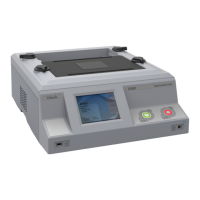The Test Conditions for Turns Ratio Measurement
Notes: The signal is applied to the primary winding, or the winding which has the
largest number of turns.
However, if by doing this, the expected voltage on the winding with the
smallest number of turns falls below 1mV, then the test voltage should be
increased.
This may also require an increase in the test frequency so that the current
taken by the driven winding does not become too large, but in general this
frequency increase should be kept as small as possible to avoid problems
caused by stray capacitance at high frequencies.
Where Matching in Groups is Important
In some transformer designs, the turns ratio between a primary winding and a
secondary winding is not as important as the ratio between different primaries or
different secondary’s.
To make the most accurate measurements in such cases apply the test signal to
the primary winding and measure the turns-ratio from primary to one of the
secondary’s.
Then, leaving the primary energized as above, measure the turns ratio between
the secondary’s.
Next, energize a secondary winding (possibly at a different voltage and / or
frequency depending on its inductance) and measure the turns ratio between the
various primaries.
In this way windings, which should be matched are treated equally during the test.

